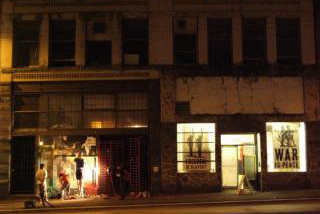
I’m mid-way through a piece for Vancouver Review on the topic of public art. As a result, I wouldn’t normally write and post anything on the topic because it might end up stealing from work to-be-published. But, with apologies to my kind and forbearing editors at VR, I’m going to make an exception here because we have an unusual and troubling art situation going down here in Vancouver: the City has threatened to shut down the Red Gate.
If you’re not familiar with it, the Red Gate is a non-profit space at 152 West Hastings Street opposite the Woodwards redevelopment. Run by Jim Carrico, it’s a kind of pure creative space (he calls it a Cultural Wildlife Refuge) where musicians and artists (street artists and others) hang out, create, and showcase their work. About three weeks ago the City gave Carrico 30 days to vacate. After a flood of protest, the City granted a 60 day extension. But the axe still hangs meaning the time has arrived for people to make themselves heard on the topic of why this closure should not happen and why Vancouverites should really care about the preservation of the Red Gate and institutions like it.
What’s driving this situation is development in the Downtown Eastside (DTES). As most Vancouverites know, the 100 block of West Hastings Street has already transformed with the completion of the new Woodward’s complex. And speaking as a 15 year tenant of the Dominion Building, at the corner of Hastings and Cambie half a block from the Red Gate, I feel qualified advancing the opinion that the Woodward’s development was sorely needed. 100 block West Hastings was never the worst block in the DTES, but when I moved my office into the area it was getting steadily worse. I saw crack use and drug sales almost every day, all the way up Hastings and into Victory Square. I remember bringing my kid to the office one weekend and having to jump in and stop him from picking up a hypodermic needle lying next to the cenotaph.
Having said that improvement was needed, it’s important to note that DTES “gentrification” was never the plan. I wrote an articlelast year about Army&Navy owner Jacqui Cohen and interviewed numerous prominent people about development of the DTES. Every one of them – including Larry Beezley, Jim Green, Bob Rennie and Cohen herself – stressed that “gentrification” was not the right approach. For the downtown, these powerful people seemed to agree, the “mixed use” model was better.
Why did they express this view? Because while “mixed use” plans try to preserve what’s best about a neighborhood through diversity, “gentrification” is what happens when you do development wrong. It means allowing lower income groups and artists to be displaced and, in the process, chasing out the established culture of a given area.
And make no mistake: there has been a distinct DTES culture. It’s about affordability, certainly. But it’s also about the sheer presence in numbers of artists, gallerists, filmmakers, writers, publishers, theater troupes, as well as a whole range of independent business people in technology, architecture, the law. What I’m describing is the kind of neighborhood on which every city vitally depends, those urban zones and spaces where small-scale creativity is expected, celebrated, and where it can thrive.
The Red Gate has been a critical part of that scene in the DTES and should be part of the neighborhood’s continued “mixed use”. I can give a personal example. I wrote a book recently, a novel called The Blue Light Project. Why? In large part due to the inspiration I found myself drawing from the DTES flourishing ecology of street art. I wasn’t a street artist. I was a total outsider. But I started my investigation at the Red Gate, where Jim Carrico arranged for me to meet the legendary Vancouver graff writer and street art historian Take5. Take was my window in, and through various introductions that followed, my own creative process was informed and stimulated. When I follow the causal chain, in other words, it goes back from my finished book through all of the people I met, through Take5 and the Red Gate, to the DTES itself.
And it seems to me that’s exactly how creativity is supposed to work in these most crucial urban zones. People are supposed to be positively infected by what’s going on around them, to be forced into an intellectual and aesthetic jostling together. Because it’s in those cultural mosh pits – at times anarchic, sure, but generating hugely productive creative energies – that new ideas are born.
New ideas. We want those. So we don’t want to stomp all over the places where they are cultivated. And that’s why people who care about this city, like those named above, may support mixed use development of the DTES, but not “gentrification” where you drive everybody out who isn’t a upmarket condo owner. That’s why, I’d reason, Gregor Robertson has reportedly said that he wants the Red Gate to stay open. Because people who care about the city recognize that gentrification is not just unfair, it kills a particular kind of urban creativity. And to do that would kill something essential to the entire city.
Let’s not let that happen. I encourage anyone who reads this post and agrees to write a letter of support to redgate@at.org. It’s not going to be easy. First thing Jim needs is an agreement from the building’s owner regarding long term occupancy, without which the building won’t qualify for the City’s Cultural Infrastructure Grant. But if enough noise is made, perhaps the pressure can be constructively applied in this case.

